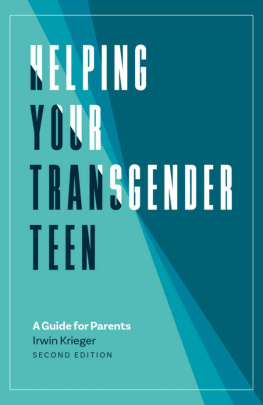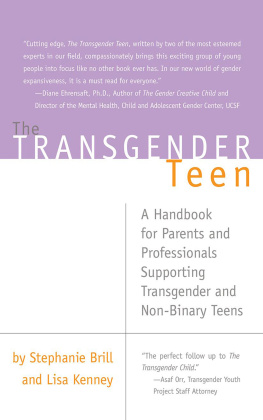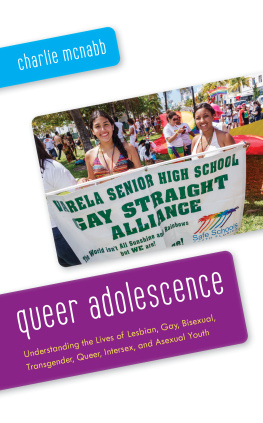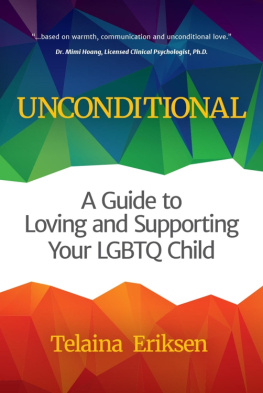Helping Your
Transgender Teen
2nd Edition
A GUIDE FOR PARENTS
Irwin Krieger
Jessica Kingsley Publishers
London and Philadelphia
Contents
Each of us deserves the freedom to pursue
our own version of happiness;
to make the most of our talents; to speak our minds; to not fit in;
most of all, to be true to ourselves.
Thats the freedom that enriches all of us.
PRESIDENT BARACK OBAMA,
FOR THE IT GETS BETTER PROJECT
Accessed on 7/31/17 at https://obamawhitehouse.archives.gov/it-gets-better-transcript
Preface to the
Second Edition
Much has changed since I began writing Helping Your Transgender Teen in 2010. Since that time there has been a tremendous increase in the visibility of transgender people in a variety of media, including many recently published memoirs. The number of YouTube videos of transgender teens sharing their experiences has grown dramatically. Transparent premiered on Amazon in 2015, winning awards and a large following. Many transgender people are involved in its production. Billions on Showtime introduced a character with a non-binary gender identity in 2017. The actor playing this role identifies as non-binary. There are reality shows and numerous documentaries showing the struggles and joys of transgender people and their families. Many of them are about the families of transgender teens and children.
In the United States, under President Barack Obama, the Department of Justice and the Department of Education issued guidelines instructing schools to respect the rights of transgender students. Even though the guidelines were rescinded by the current politically conservative administration, the laws upon which the guidelines were based are still in force.
In 2013, the Maine High Court ruled that schools in Maine must allow a transgender student to use the bathroom that matches their gender identity. Many colleges now include discussion of gender identity in their student orientations. Eighteen U.S. states and the District of Columbia have laws regarding transgender rights as of 2017. Most were passed in the last few years. More families in the U.S. have insurance coverage that includes transgender health care.
All of these changes show that Americans are increasingly aware of and accepting of transgender people. In most places in the U.S., transgender people are better able to live their lives authentically and receive fair treatment than they were seven years ago. Of course, there is still a long way to go before we reach full acceptance and equal legal rights for transgender individuals.
At the same time that all these changes have occurred, there has also been a significant increase in teens coming out with non-binary gender identities. As I explain in the Introduction, these are teens who identify as neither male nor female, or a blend of the two. This is the change that prompted me to revise and update my book. Prior to 2010, when I began writing the first edition, the only trans people talking to me about non-binary identities were young adults. They were most often college students who sought therapy to explore their sense of being neither male nor female or a little of both. Generally, they met with me for a period of a few months, appreciated the opportunity to talk about this at length, clarified a few things for themselves and were on their way.
In fact, the first edition of Helping Your Transgender Teen included my belief at that time that most teens who come out as transgender are seeking transition from male to female or female to male, while those with non-binary identities are more likely to handle this in secret or be seen as rebelling, unconventional or just going through a phase. In the years since then, identifying as non-binary has become common among transgender teens. I am revising this book to be helpful to parents whose youth identifies as non-binary, while continuing to include all of the relevant information for parents of teens making a transition from male to female or female to male. Since many teens are uncertain of the exact nature of their transgender identity when they first disclose to parents, you may be reading this book as the parent of a teen who has not determined the specifics of their identity. It is important for you to be aware of the full range of gender identities and the many possible ways your teens life may unfold.a
Title IX requires gender equity for boys and girls in every educational program that receives U.S. government funding. The Family Educational Rights and Privacy Act (FERPA) protects the privacy of student education records.
Age of Individuals Who Identify as Transgender in the United States. J.L. Herman, A.R. Flores, T.N.T. Brown, B.D.M. Wilson and K.J. Cronin. The Williams Institute, UCLA School of Law, 2017.
Helping Your Transgender Teen: A Guide for Parents. Irwin Krieger. Genderwise Press, 2011, p.7.
Introduction
Todays teens have access to a wealth of information about gender identity on the internet. Young people wondering about gender will soon discover what it means to be transgender. They will learn about the experiences of transgender teens and adults and the options people have for changing their body to conform to how they feel inside. Many parents of masculine girls or feminine boys have considered that their child may be gay or lesbian. Usually they do not imagine that their child could be transgender.
How this book will help you
If you are the parent of a transgender teen, this book will help you understand what your child is feeling and experiencing. It will explain what may be in store for you if your child fully embraces being transgender. Most parents do not know anyone who is transgender. They initially approach the subject with tremendous discomfort. It is extremely important as the parent of a transgender child to educate yourself about the variety of gender identities that exist. Be prepared to let go of some of your ideas about what it means to be male or female.
These ideas may have been shaped by your childhood. When you were growing up you learned what it meant to be a boy or a girl. Perhaps what you learned felt right to you and you never gave it much thought. Or perhaps there were times when you felt fenced in by what others expected of you because you were a girl, or because you were a boy. You may have been kept from certain activities or discouraged from pursuing certain interests because of your gender. Most likely by adulthood you figured out how to make your way in the world without questioning whether you are a woman or a man. If you are reading this book, however, someone you care about is struggling with questions about gender.
When teenagers declare they are transgender, parents fear that their child is confused and is choosing a life fraught with danger. As a parent, it is best to be thoughtful, inquisitive and compassionate as you come to understand more about your childs gender identity.
Why I wrote this book
I am a clinical social worker who provided psychotherapy for lesbian, gay, bisexual and transgender (LGBT) individuals and their families for over 30 years. From 2004 onward, my work included more and more transgender teens and their parents. I want to share with you what I have learned from my years of working with these caring and courageous families.
Right now, you may be feeling confused, angry, highly skeptical or completely disbelieving that your child could be transgender. If so, this book is for you. In the next chapter Ill help you understand the words and ideas we use when we talk about gender identity. The following three chapters will highlight gender nonconforming children, the differences between gender and sexuality, and the challenges of adolescence for transgender kids. The remaining chapters will help you address your fears, concerns and uncertainties about your child, so you can be as supportive as possible while your child continues to explore questions about gender identity.












